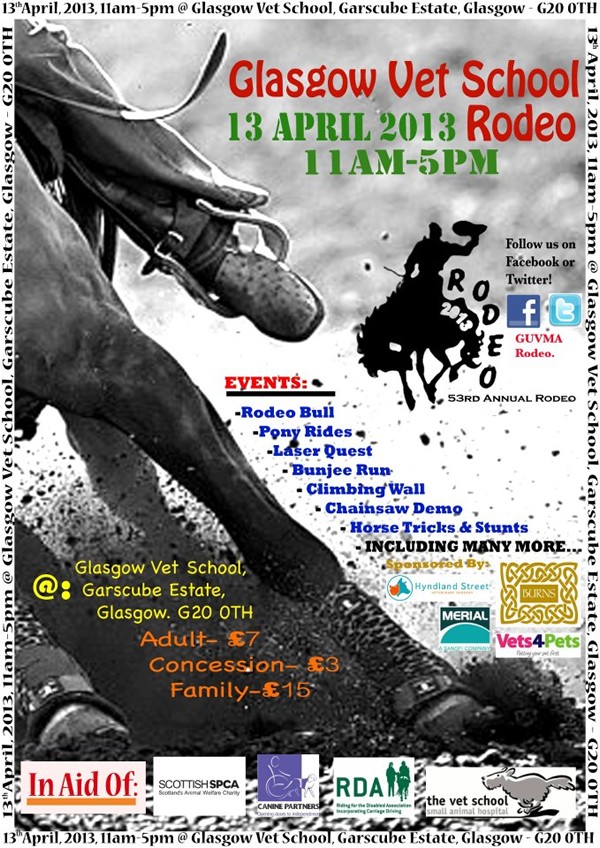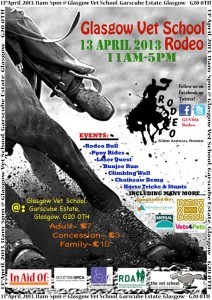Over the course of the last week, Great Britain has said an uncomfortable “hello” to two of its more nefarious foes, in the form of avian influenza (Suffolk) and the Schmallenberg virus (Dumfriesshire). (more…)
Blog
-

Rodeo time!
With pre-exam stress in full swing for most of us, we welcomed a break in the form of the Glasgow Vet School Rodeo last weekend. The annual charity event took place for the 53rd time this year.

Poster for the 53rd Glasgow Vet School Rodeo Traditionally (from what I can gather), it used to be somewhat like a country show, with stock showing, sheep herding and the like. Now, it’s more of a family day out with many displays and stalls of different natures, though all loosely animal-related.
Entertainment throughout the day included displays such as falconry, duck herding and dog sledding. There was have-a-go dog agility and dog showing for the public to enter their pets into. For the children, there were pony rides, bouncy castles, laser quest and a climbing wall. Of course, there was a marquee full of craft stalls and all sorts of different tombola and raffle stands supporting various animal related charities.
The proceeds from the entry tickets and the main raffle went towards four key charities: The Riding for the Disabled Association, Canine Partners, The Scottish Society for the Prevention of Cruelty to Animals (Scottish SPCA) and The Vet Fund (James Herriot Scholarship Fund). In addition to these, many other animal and breed-specific charities had their own stalls.
It is a vet school tradition that first years “volunteer” on the day. My friend and I spent the morning helping out on the “small animal” stand – there were a selection of small furries including rabbits, hamsters, mice and guinea pigs available for the public (mainly children) to handle. Our role was to help get the animals out of their cages and make sure there were no escapees. Other than my small disagreement with a rat (it sank its teeth into my finger in response to being picked up), we enjoyed our time chatting to people and brushing up on our handling skills.
In true Glasgow style, the day ended with a ceilidh – a great day and evening was had by all of us at the vet school!
-
My barking mad challenge
You know you’re going somewhere remote when your first exchange with a local Norwegian at the airport is: “People don’t go to Alta, people get sent to Alta.”

Alaskan Huskies in Norway. Credit: Pater McFly Joking aside, Alta is a fairly small community well into the Arctic Circle, and we were leaving civilisation behind altogether by venturing into the wilderness with seven sleds and 32 huskies. The cabins we stayed at varied in facilities – some had running water and electricity but, at some, we had to keep a fire going for warmth and drill into a frozen lake for drinking water. It really did feel like we’d left the real world far behind.
On the first day, we were introduced to our dogs and shown how to harness them correctly to the sled. Before long, we were tearing across the snow, astounded at the dogs’ enthusiasm, strength and speed. They were as friendly as pet dogs and yet much hardier with a relentless attitude towards their work. They slept outside in the snow and pulled the sleds for hours on end without tiring. And each had an individual character.
Whenever we hit an incline and they started to slow, we had to jump off and run with them or scoot to help them out. Leaving them to it was not an option; if we were slacking, the dogs would just stop and turn round to look at us. They don’t need the power of speech – it was easy to see what they were thinking!
But it wasn’t just a case of jumping on the sled in the morning, traveling for five or six hours, and then collapsing. We looked after the dogs’ every need before we settled down each night. Having no TV or internet meant that our group of seven (including the expedition leader and trip doctor) really bonded over the course of the week.
I think the second day was the most physically demanding. Not because there were many hills (that day was actually quite flat), but because muscles I didn’t even know I had were aching. Despite all the training, everyone seemed to be feeling the strain. I don’t think I could have trained more, but think this was simply down to the fact that it’s a completely different type of exercise to running or cycling or swimming. That day, I really did have to make myself get off and run when the dogs needed a bit of extra help. But I kept reminding myself why I was doing it and kept going.
Lying in hospital with 12 broken ribs, I would never have thought that, two years on, I would be mushing my own team of huskies across Norway. I can’t thank the Warwickshire and Northamptonshire Air Ambulance (WNAA) enough – I genuinely believe that they saved my life the day that I fell from that horse. I think it’s important to keep raising awareness and funds for the charity so that they can continue to save lives.
So that’s how I came to be stood on a sled in the North of Norway. It was tough at times but I thoroughly enjoyed the experience and am grateful that I had so much support with raising money for the charity.
-
Help raise rabbit awareness
Organisers of Rabbit Awareness Week (RAW) are calling on the UK veterinary profession to help highlight and educate about the importance of preventive health care for the nation’s third most popular pet by signing up to the free initiative. (more…)
-
Luck of the draw
During the Easter holidays, I had my first EMS placement. Although I’d hand-reared cade lambs before, I’d never actually been lambing. Someone in the year above at Glasgow had been to the farm that I and some of my friends had arranged to go to. While they said it would be a good placement, we still didn’t really know what to expect.

Luckily, the farmer didn’t just set us doing menial tasks such as feeding and watering. It turned out that it probably couldn’t have been better. We got a really friendly farmer who explained everything to us and seemed to strike the balance perfectly between teaching, supervision and leaving us to it when confident enough.
He also didn’t just set us doing menial tasks such as feeding and watering. Of course, we did do some, but he was eager to get us involved in as much lambing as possible and more “vetty” tasks such as injecting sheep or lambs, tube-feeding colostrum and worming. It definitely seemed like he went out of his way to make sure we experienced all aspects of ewe and lamb care during lambing time.
While talking to both the farmer and the other students that were there, we discussed horror stories of placements other people had been on. We’d heard of people sleeping in caravans, cooking for themselves (in said caravan) and being abandoned with very little instruction with a field of lambing sheep. Having warm beds to sleep in the farmhouse, home cooking and as much food as possible thrown at us, we felt very lucky, considering what we could have ended up with.
Unless a placement has been recommended, it is very much luck that determines what sort of accommodation or people you’ll end up working with. We were so grateful to draw the long straw with lambing. It would have been very easy to end up with a placement on which we wouldn’t learn or do nearly as much.
-
Renal proteinuria
Renal proteinuria is an important complication of chronic renal disease.
The presence of proteinuria is not only a marker of renal injury but also an important independent mediator of progressive renal injury.
Dipsticks are insensitive in documenting proteinuria. The urine protein creatinine ratio offers the best means of assessing the severity of proteinuria and correlates well with 24 hour protein loss.
Healthy cats should have a UPC ratio of <0.2.
-
Feline asthma

Image © iStockphoto.com/deepblue4you A young cat in good condition with a history of coughing and mixed dyspnoea with increased abdominal effort on expiration is most likely to have feline asthma.
Although chest radiographs are necessary to confirm, harsh lung sounds in all fields and the absence of a heart murmur or gallop rhythm makes the diagnosis of asthma very likely.
-
Do something amazing – give (your pet’s) blood
I had heard of the Pet Blood Bank before, but only when it was mentioned in one of our blood lectures did I start wondering. I don’t know how often veterinary professionals make use of the service in general practice, but I do think it’s fantastic that a resource like this is available to help save the lives of sick dogs.

A Parson Jack Russell terrier receiving a blood transfusion for treatment of severe anaemia as a consequence of rat bait toxicity. Credit: Pet Blood Bank UK. Set up in 2007 after a change in legislation allowing collection, processing and storage of pet blood, it is a fairly new charity.
This is a classic example of just how recent and non-routine a procedure is in veterinary compared to how commonplace it is in human medicine. It is understandable why blood transfusions are less often thought of in the veterinary world. While animal blood-typing is less well understood and more complicated than human blood-typing, we also have to take ethical decisions, considering the healthy donor dog cannot choose whether to surrender some of his/her blood.
However, I think that the benefits of having a pet blood bank outweighs the ethical conundrum, as long as the donor is healthy and any risks are minimised. Blood transfusions can be life-saving, and we should embrace the opportunity to provide dogs with the same medical advancements as are available in human medicine.
We should not only support the work of the Pet Blood Bank, but also promote it and try to increase awareness throughout not only the veterinary world but in the general public as well. By raising the profile of the charity, more donors will come forward and more funding can become available to extend the service in order to provide other pets, such as cats and horses, with an equally life-saving resource.
-
Microhepatica on radiographs
Because the liver may be contained entirely within the rib cage in normal cats and dogs, microhepatica is more difficult to recognise than hepatomegaly.
Changes in the angle of the gastric fundus in the right lateral projection could indicate a small hepatic shadow if the angle is more upright or perpendicular to the spine – especially if the stomach seems close to the diaphragm.
The liver may also seem small in animals with traumatic diaphragmatic hernia and herniation of liver lobes into the thorax or in those with congenital peritoneopericardial hernia.





